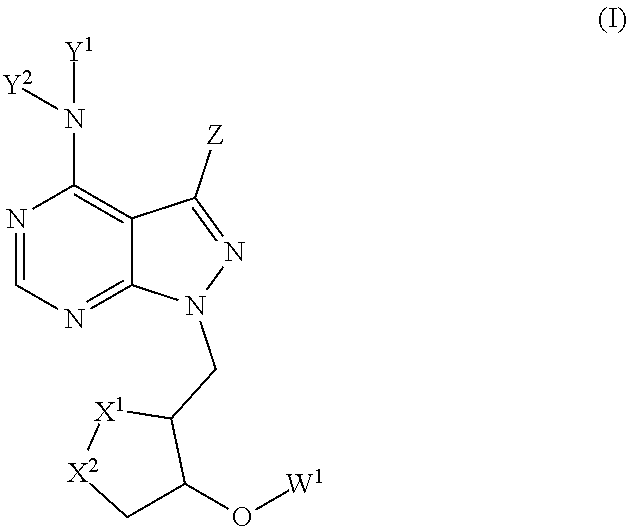1,2-dithiolane compounds useful in neuroprotection, autoimmune and cancer diseases and conditions
a technology of dithiolane and dithiolane, which is applied in the field of new 1, 2dithiolane, can solve the problems of cancer being a major global problem, and achieve the effect of improving, treating or preventing cancer
- Summary
- Abstract
- Description
- Claims
- Application Information
AI Technical Summary
Benefits of technology
Problems solved by technology
Method used
Image
Examples
example 1
[0330]
[0331]The compound (2S,3S)-1,4-dimercaptobutane-2,3-diol (4 g, 25.9 mmol) was dissolved in dimethylsulfoxide (2.3 g, 28.5 mmol) in an open beaker and heated to 110° C. with stirring for 3 hours. The reaction mixture was then cooled and dimethylsulfoxide was removed under vacuum to give a residual oil which was kept at room temperature for 20 minutes after which a white semi-solid was formed. About 25 mL of diethyl ether were added and the mixture was stirred for 10 minutes, then filtered. The solid was dried under vacuum to give a white solid (3.5 g, yield 90%). 1H NMR 400 MHz (DMSO-d6): δ 5.23 (d, J=4.0 Hz, 2H), 3.39 (m, 2H), 3.06-3.02 (m, 2H), 2.54-2.50 (m, 2H); LCMS m / e: 135 [M+H−18]+.
example 2
[0332]
[0333]The compound (2R,3S)-1,4-dimercaptobutane-2,3-diol (2.5 g, 16.2 mmol) was dissolved in dimethylsulfoxide (1.4 g, 17.9 mmol) and in an open beaker was heated to 110° C. with vigorous stirring. After 3 hours, dimethylsulfoxide was removed under reduced pressure and the residual reaction mixture was allowed to stand at room temperature for 20 minutes. A white semi solid was formed to which was added diethyl ether (25 mL) and stirred for 10 minutes, then filtered. The resultant solid was dried under vacuum to give a white solid (2.3 g, yield 92%). 1H NMR 400 MHz (DMSO-d6): δ 4.94 (m, 2H), 3.71 (m, 2H), 2.99-2.96 (m, 4H); LCMS m / e: 135 [M+H−18]+.
example 3
cis-1,2-Dithiane-4,5-diol
[0334]
[0335]A solution of dithioerythritol (DTE, 22.0 g, 0.14 mol) in 537 mL of water was treated with potassium ferricyanide (0.8 M) solution (0.29 mol in 358 mL of water) until the yellow color persisted while maintaining pH 7 by addition of 2N KOH (0.29 mol in 143.2 mL of water). The solution was evaporated to dryness and 200 mL of ethanol was added to the crude product. After filtration, the clear filtrate was evaporated to dryness and crystallized from ethyl acetate / hexanes (2:1). The product was isolated by filtration as a white crystalline solid: m.p. 130-132° C.; 1H NMR (DMSO-d6, 300 MHz) δ 2.70-3.00 (br s, 2H), 2.99 (dd, J=8.0, 13.2 Hz, 2H), 3.60-3.80 (br s, 2H), 4.80-5.00 (br s, 2H).
PUM
 Login to View More
Login to View More Abstract
Description
Claims
Application Information
 Login to View More
Login to View More - R&D
- Intellectual Property
- Life Sciences
- Materials
- Tech Scout
- Unparalleled Data Quality
- Higher Quality Content
- 60% Fewer Hallucinations
Browse by: Latest US Patents, China's latest patents, Technical Efficacy Thesaurus, Application Domain, Technology Topic, Popular Technical Reports.
© 2025 PatSnap. All rights reserved.Legal|Privacy policy|Modern Slavery Act Transparency Statement|Sitemap|About US| Contact US: help@patsnap.com



